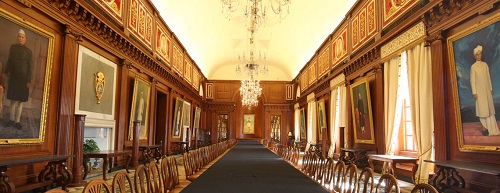How is the President of India Elected?
India is all set to choose its next President. But, how is this done and what does the President of India do?
India is all set to choose its next President. But, how is this done and what does the President of India do?
A quick look…
The presidency is currently headed by Mr. Ram Nath Kovind, whose term is ending on 24th July 2022.
When will the election be held?
It’ll take place on July 18 and the result will be declared on July 21.
Who conducts the election?
The election commission of India (EC) – an independent body that regulates the elections process and makes sure that they are held in a fair manner.
It is authorized under the Presidential Elections Act, 1952 by the constitution to conduct presidential elections every 5 years to nominate a worthy candidate to the president’s office.
How is the president elected?
What’s important to know is that there’s no direct election for the Indian President. He or she is elected by, what’s called the electoral college.
Who all are part of the electoral college?
It comprises elected members of the following bodies:
- The Lok Sabha
- The Rajya Sabha
- Legislative Assemblies (of the states of India)
- Legislative Assemblies of the Union Territories of Delhi and Puducherry
The election procedure
The voting at the Presidential Election will be carried out by secret ballot under the single transferable vote system which simply means “one person, one vote”
A ballot box refers to a sealed box used for casting votes. The seal is only broken during the counting of votes and ballot paper refers to the piece of paper that candidates use to record their votes. It mostly has the choices mentioned for voters to choose from.
To break it down, each voter can choose only one candidate on the given ballot paper, which will have to be folded and sent through a narrow slot in the ballot box so no one except the box will know who you voted for.
As per the notices published on June 15, 2022. Upon entering the booth, each voter would be provided with a different violet ink pen issued by the returning officer(RO) to record their votes with utmost secrecy.
The returning officer is an appointed official, who is in charge of conducting the elections and returning the ballot box safely.
To further ensure the secrecy of the ballot, the ballot papers may be issued to the voters at the beginning of the poll at random instead of a strict order of their serial number.
To put it simply, even the EC officials won’t be able to figure out the identities of voters by tracing back the order of votes.
In a press conference, EC specified that the value of the vote of an MP would be 700. The value of a vote is calculated using a formula that divides the total population of the state by a multiplied sum of the total number of assembly seats of the state to a thousand.
Why the secrecy?
The votes are kept confidential to ensure impartial and uninfluenced voting. Without any external pressure or fear, the candidates can vote for whoever their conscience dictates.
Who can be a candidate
To qualify as a candidate for the presidency, a person has to be:
- A citizen of India
- Should be qualified for election as a member of the House of the People.
- She/he should be over 35 years of age.
- She/he should not hold any office of profit under the central or state government, or any other public authority.
Process
- The candidate has to file the nomination papers per the guidelines prescribed by the Election Commission.
- The form is only accepted if it is supported by at least 50 electors as proposers and 50 electors as seconders.
- Along with the nomination paper, a security deposit of 15000 rupees is also required to be made by the candidate in the Reserve Bank of India or a government treasury under the relevant head of accounts.
According to the notice issued by the election commission. “The nominated members of either Rajya Sabha and Lok Sabha or Legislative Assemblies of the States are not eligible to be included in the Electoral College and therefore, they are not entitled to participate in the election. Similarly, members of the Legislative Councils are also not electors for the Presidential election”
Who can vote?
In the notice released on 9th June 2022, the election commission concluded that all the members of the electoral college would be legally allowed to vote in the upcoming elections.
To put it simply, as stated earlier, all the members of Lok Sabha and Rajya Sabha and elected members of the legislative assemblies of all states (MLAs), including the National Capital, Delhi, and the Union Territory of Puducherry are the legitimate voters.
But, here’s something to know
Some votes have a larger value. An MP’s vote, for example, carries a value of 700.
For the MLAs, the values are not the same for all. This is calculated according to the population of each state. So, in states with a larger population, like Uttar Pradesh, an MLA carries a vote value of 208, whereas, in lesser populated states like Arunachal Pradesh and Sikkim, the value of a vote for an MLA is only 8!
The election commission is providing the list of all the electors of the 2022 presidential election for sale at Rs. 300 via a counter opened on the premises of the Election Commission of India.
Who are the candidates for the 2022 election
According to parliamentary sources, eleven candidates have filed their nomination papers for the upcoming presidential polls on the first day itself!
The EC is yet to publish an official listing. But some prominent names that have been making rounds of political battleground include the current governor of Kerala, Mohammad Arif Khan, the former Union Defence Minister and the former Lok Sabha Speaker Sumitra Mahajan. The sitting Chhattisgarh governor, Anusuiya Uikey’s name is also surfacing among the potential candidates.
The Bharatiya Janata Party(BJP), with 301 members in Lok Sabha and 95 in Rajya sabha is believed to be riding the wave of this poll until the opposition digs out a strong candidate. There is no safe bet but the curtain will be raised once and for all on July 21, 2022.
About the president
The president of India is the head of the state and the Commander-in-Chief of the Indian Armed Forces.
According to the constitution of India, the president is the supreme power and acts as the formal head of the executive, legislature, and judiciary bodies of India, these refer to the three bodies of the union government.
The legislatures function as the “law-makers” and the executives are responsible for the implementation of those laws and policies while the judiciary carries out justice through the laws written in the constitution.
Responsibilities
The President of India acts as the commander in chief of all the Indian armed forces. He/she is also responsible for appointing the Chief Justice of India, who in turn assists the president in selecting the other justices of the supreme court.
The President shall nominate a vice president in case there is a vacancy in the office, and the nominated candidate shall take office upon confirmation by a majority vote in both houses of the parliament.
The president of the Republic of India also nominates twelve members of the Rajya sabha, who have made notable contributions to the nation in the fields of art, literature, science, and social service. All the foreign treaties are signed under his name. All the bills passed by majority votes in the houses of the Parliament can become laws only if they’re signed by the president under a ten-day tenure.
The president holds the power to dissolve Lok sabha and he/she/they also has the power to grant pardons to law offenders in case of death penalties.
In a nutshell…
The president of India is responsible for upholding the verdict of the constitution and for overseeing the Prime Minister and lawmakers by ensuring that the laws and operations are run according to the constitution of India.
Here’s a list of all the former presidents of India
Where does the president of India live
The president of India lives in the Rashtrapati Bhavan, in New Delhi.
About Rashtrapati Bhavan

Image source: rashtrapatisachivalaya.gov.in/rbtour/
Its architects were the famous Sir Edwin Lutyens and Herbert Baker. It was Sir Lutyens who conceptualized the H-shaped building, which covers about 5 acres on a 330-acre estate.

Image source: rashtrapatisachivalaya.gov.in/rbtour/
There are a total of 340 rooms spread over four floors, 2.5 kilometres of corridors, and 190 acres of garden area.

Image source: rashtrapatisachivalaya.gov.in/rbtour
The Rashtrapati Bhawan was originally built to be the residence for the Viceroy of India and was called the Viceroy’s House at the time of the British.
I Kid You Not now has a large readership across India and also parts of the world. If you want to write for us, you can submit your story here. You can also apply to become a news anchor. Apply here
Headline image source: https://upload.wikimedia.org/wikipedia/commons/6/63/Rashtrapati_Bhawan-New_Delhi.jpg
Attribution:
Rashid Jorvee, CC BY-SA 4.0 https://creativecommons.org/licenses/by-sa/4.0, via Wikimedia Commons



Comments